The anatomy and life of a red-eyed tree frog

Image copyright: http://animaldiversity.ummz.umich.edu
Kingdom: Animalia
Scientific Name: Agalychnis callidryas
Anatomy
Frogs have many of the same body systems that humans do. For example, frogs have a digestive, respiratory, circulatory, musculoskeletal, nervous, and urogentital system. Each system in a frogs body performs a certain function. The digestive system makes energy available to the frog. The circulatory system moves chemical substances, blood, through the body. The urogenital system gets rid of the waste in a frogs body and also is responsible for reproduction..
The digestive system contains a mouth, stomach, large intestine, and small intestine. Food enters the mouth and is broken down mechanically by chewing. The food then travels to the stomach where it is chemically processed by stomach acid, or bile. The food travels to the intestines where nutrients are absorbed into the body. Finally the waste is prepared to exit the body.
The circulatory system contains a heart, arteries, and veins. The function of the heart is to move chemical substances, mainly blood, through the body of a frog. The arteries are designed to move blood filled with oxygen from the heart to the rest of the body. Veins are designed to move oxygen poor blood into the heart.
The musculoskeletal system contains the bones and muscles in a frogs body. Bones, which are the major organs in the skeletal system are designed to support the body of the frog. Muscles, which are the major organs of the muscular system, are designed to work together to move the frog around.
The urogenital system includes the excretory and reproductive systems. The excretory system is designed to get rid of waste and the reproductive system is designed to continue the population of the species. The urinary bladder, which is part of the excretory system, is designed to remove liquid waste from the frog.
Nutrition
Habitat
Adaptations
Fun Facts
